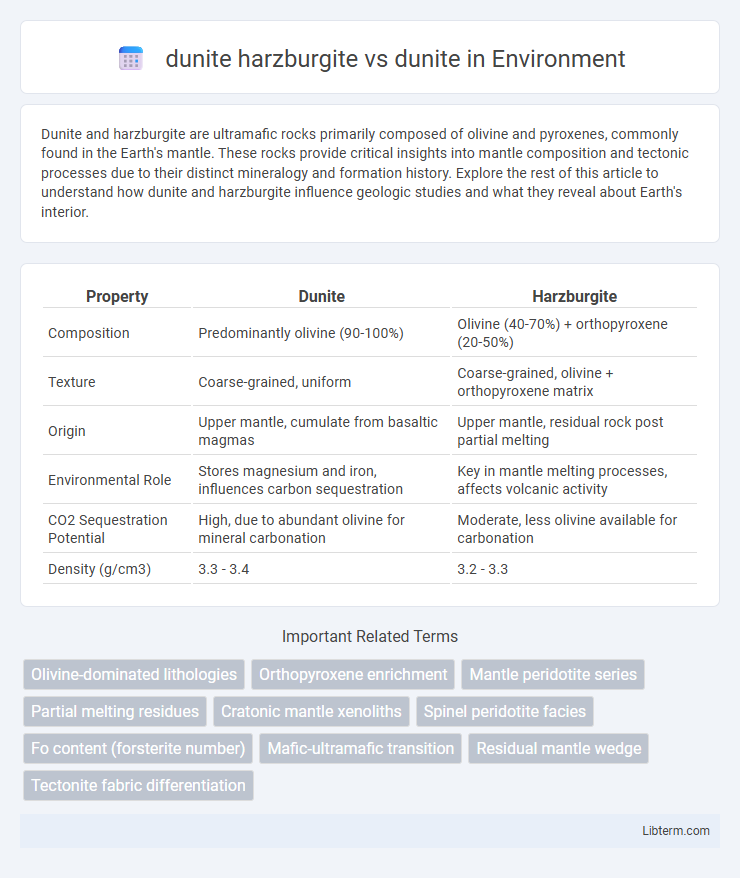Dunite and harzburgite are ultramafic rocks primarily composed of olivine and pyroxenes, commonly found in the Earth's mantle. These rocks provide critical insights into mantle composition and tectonic processes due to their distinct mineralogy and formation history. Explore the rest of this article to understand how dunite and harzburgite influence geologic studies and what they reveal about Earth's interior.
Table of Comparison
| Property | Dunite | Harzburgite |
|---|---|---|
| Composition | Predominantly olivine (90-100%) | Olivine (40-70%) + orthopyroxene (20-50%) |
| Texture | Coarse-grained, uniform | Coarse-grained, olivine + orthopyroxene matrix |
| Origin | Upper mantle, cumulate from basaltic magmas | Upper mantle, residual rock post partial melting |
| Environmental Role | Stores magnesium and iron, influences carbon sequestration | Key in mantle melting processes, affects volcanic activity |
| CO2 Sequestration Potential | High, due to abundant olivine for mineral carbonation | Moderate, less olivine available for carbonation |
| Density (g/cm3) | 3.3 - 3.4 | 3.2 - 3.3 |
Introduction to Dunite and Harzburgite
Dunite is an ultramafic igneous rock predominantly composed of olivine, typically containing over 90% olivine minerals, making it rich in magnesium and iron. Harzburgite, a type of peridotite, consists mainly of olivine and low-calcium orthopyroxene, with less olivine than dunite but more pyroxene minerals, indicating a different formation process in the Earth's mantle. Both rocks are significant in studying mantle composition and magmatic processes, with dunite representing nearly pure olivine accumulation and harzburgite reflecting partial melting and melt extraction.
Geological Formation of Dunite
Dunite primarily forms through high-temperature mantle processes involving partial melting and melt extraction, resulting in its nearly pure olivine composition. In contrast, harzburgite is a more complex peridotite composed mainly of olivine and orthopyroxene, indicative of a higher degree of melt depletion during mantle melting. The formation of dunite often represents localized zones of intense melt-rock interaction or melt channeling within the mantle, reflecting dynamic mantle metasomatism and deformation.
Geological Formation of Harzburgite
Harzburgite forms primarily in the upper mantle through partial melting processes, where basaltic components are extracted from peridotite, enriching it in olivine and low-calcium pyroxenes. Unlike dunite, which is almost entirely composed of olivine and typically results from melt accumulation, harzburgite represents a residual mantle rock reflecting melt depletion. Its genesis is crucial for understanding mantle metasomatism and the chemical evolution of the Earth's lithosphere.
Mineral Composition: Dunite vs Harzburgite
Dunite is predominantly composed of olivine, typically over 90%, with minor amounts of chromite and other accessory minerals, making it a nearly monomineralic ultramafic rock. Harzburgite contains a more balanced mineral composition of olivine and low-calcium orthopyroxene, usually around 40-50% each, with minor clinopyroxene and trace spinel, reflecting a more complex formation history. The key difference lies in the pyroxene content: dunite lacks significant pyroxene phases, while harzburgite has notable orthopyroxene presence, affecting its texture and geochemical properties.
Texture and Structure Differences
Dunite primarily consists of over 90% olivine, exhibiting a coarse-grained, equigranular texture with a granular interlocking crystal structure. In contrast, harzburgite is an ultramafic rock composed mainly of olivine and orthopyroxene, displaying a more heterogeneous texture with a crystalline matrix that is less uniform due to the presence of multiple mineral phases. The structural difference arises from dunite's relatively homogenous olivine crystals versus harzburgite's interstitial arrangement of olivine and orthopyroxene, leading to varied mechanical properties and deformation behaviors.
Occurrence and Distribution Worldwide
Dunite primarily occurs in ophiolite complexes and mantle xenoliths, characterized by its high olivine content, while harzburgite contains significant orthopyroxene alongside olivine and commonly appears in subduction zone settings and mantle peridotite massifs. Dunite deposits are widespread, with notable occurrences in the Oman ophiolite, the Betic-Rif orogen, and the Josephine ophiolite in the United States, whereas harzburgite is extensively found in regions such as the Lherz massif in France, the Ronda massif in Spain, and the Semail ophiolite in Oman. The global distribution of both ultramafic rocks reflects mantle processes and tectonic environments, with dunite more linked to mantle dunite pods and harzburgite to residual mantle after partial melting.
Industrial and Scientific Uses
Dunite and harzburgite differ significantly in their industrial and scientific applications due to their mineral composition; dunite, rich in olivine, is extensively used in refractory materials, carbon sequestration, and as a source of magnesium and nickel. Harzburgite, containing both olivine and orthopyroxene, is studied for mantle geochemistry and petrology, providing insights into mantle melting processes and tectonic settings. Industrially, harzburgite's lower olivine content limits its use compared to dunite, though its unique properties facilitate specialized research in geoscience and mineral exploration.
Geochemical Properties Comparison
Dunite and harzburgite differ significantly in their geochemical properties, with dunite primarily composed of over 90% olivine, resulting in higher magnesium oxide (MgO) content typically exceeding 45%, while harzburgite contains a mixture of olivine and orthopyroxene, leading to a lower MgO content around 40-45%. Harzburgite generally exhibits higher concentrations of aluminum oxide (Al2O3) and calcium oxide (CaO) due to orthopyroxene presence, contrasting with dunite's minimal amounts. Trace element patterns in harzburgite often show enrichment in compatible elements like nickel and chromium, reflecting its residual mantle characteristics compared to the more homogenous geochemistry of dunite.
Identification in the Field
Dunite is primarily composed of over 90% olivine, making it identifiable by its uniform greenish color and coarse-grained texture. Harzburgite contains significant amounts of orthopyroxene along with olivine, resulting in a speckled appearance and a slightly harder texture. Field identification relies on visual texture differences and simple hardness tests, with harzburgite often showing less uniformity and a more varied mineral composition compared to dunite.
Summary: Key Differences and Similarities
Dunite primarily consists of over 90% olivine, while harzburgite contains a significant amount of orthopyroxene along with olivine, making their mineral compositions distinct. Both dunite and harzburgite are ultramafic rocks originating from the Earth's mantle and share similar high magnesium and low silica contents. Their textural differences reflect variations in mantle processes, with dunite often representing more olivine-rich residues and harzburgite indicating partial melting or melt extraction events.
dunite harzburgite Infographic

 libterm.com
libterm.com